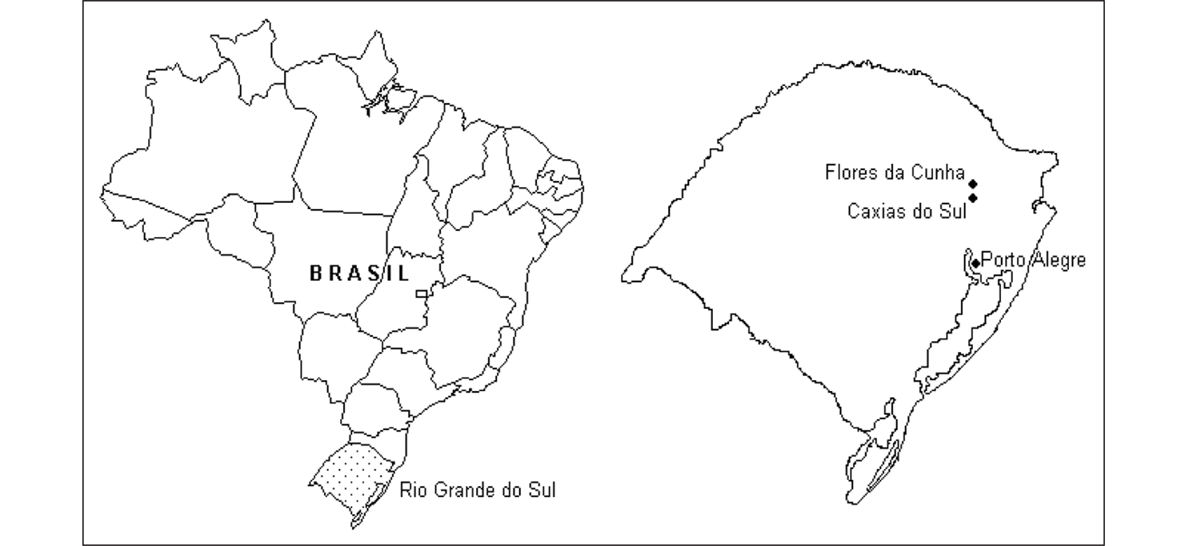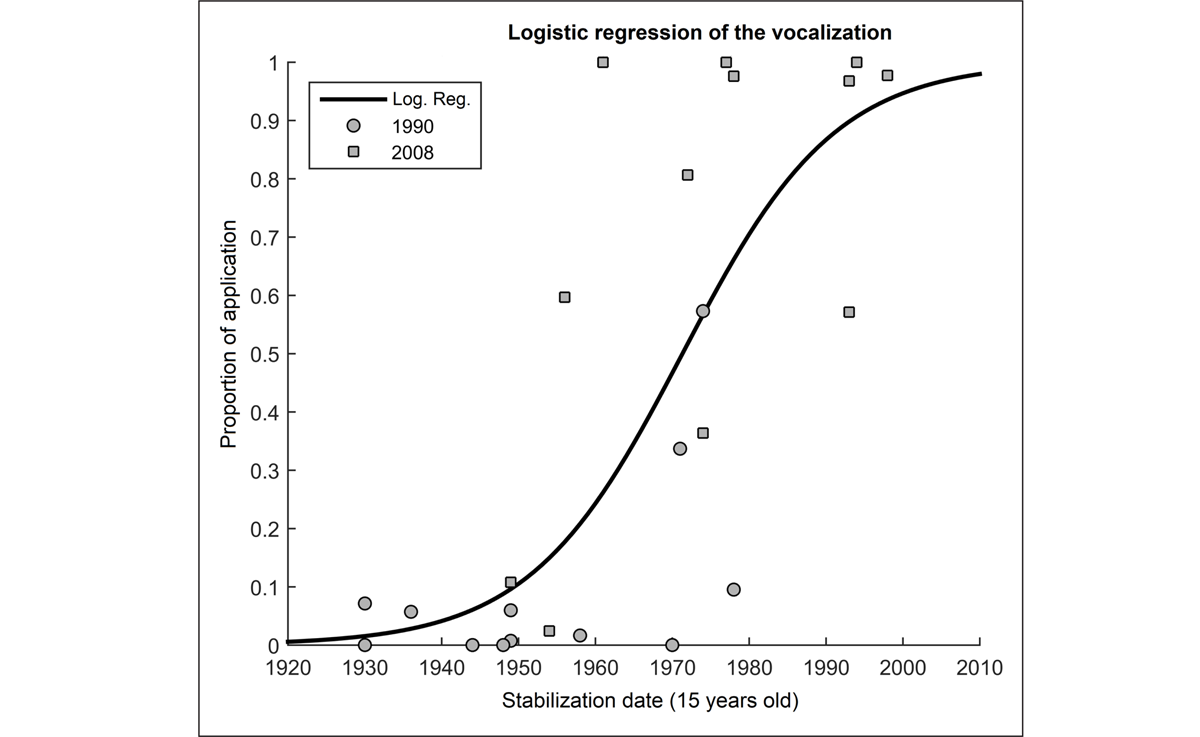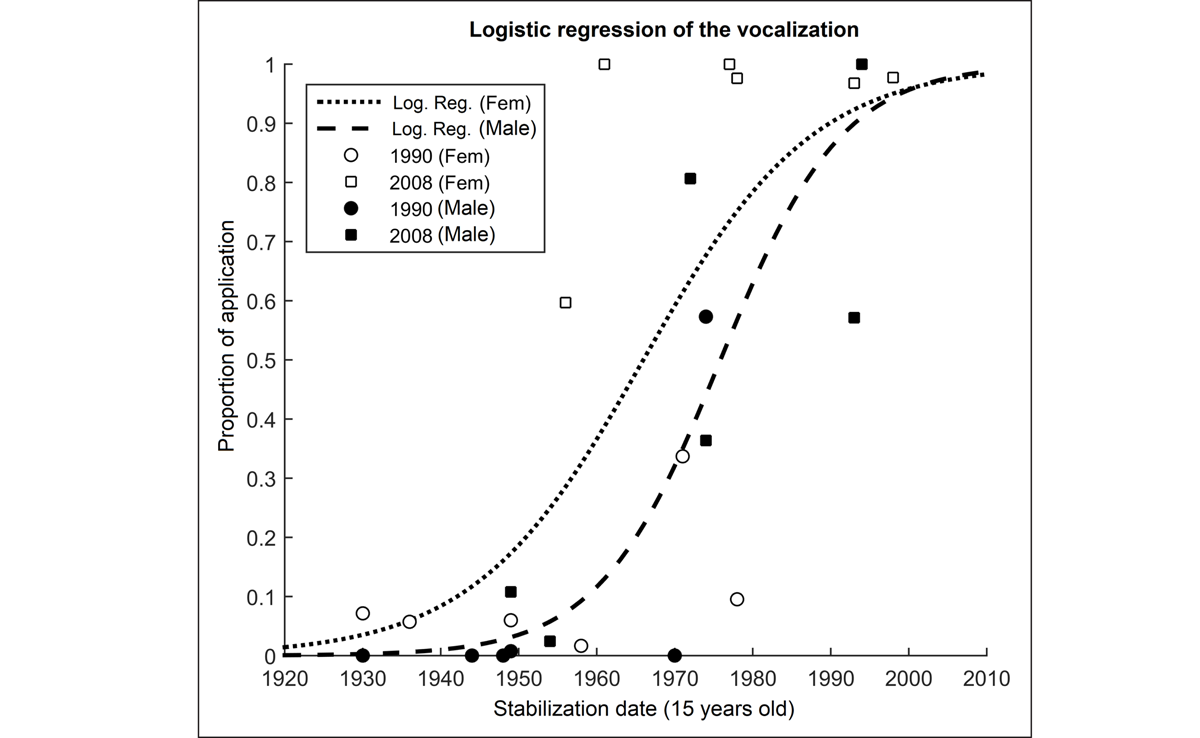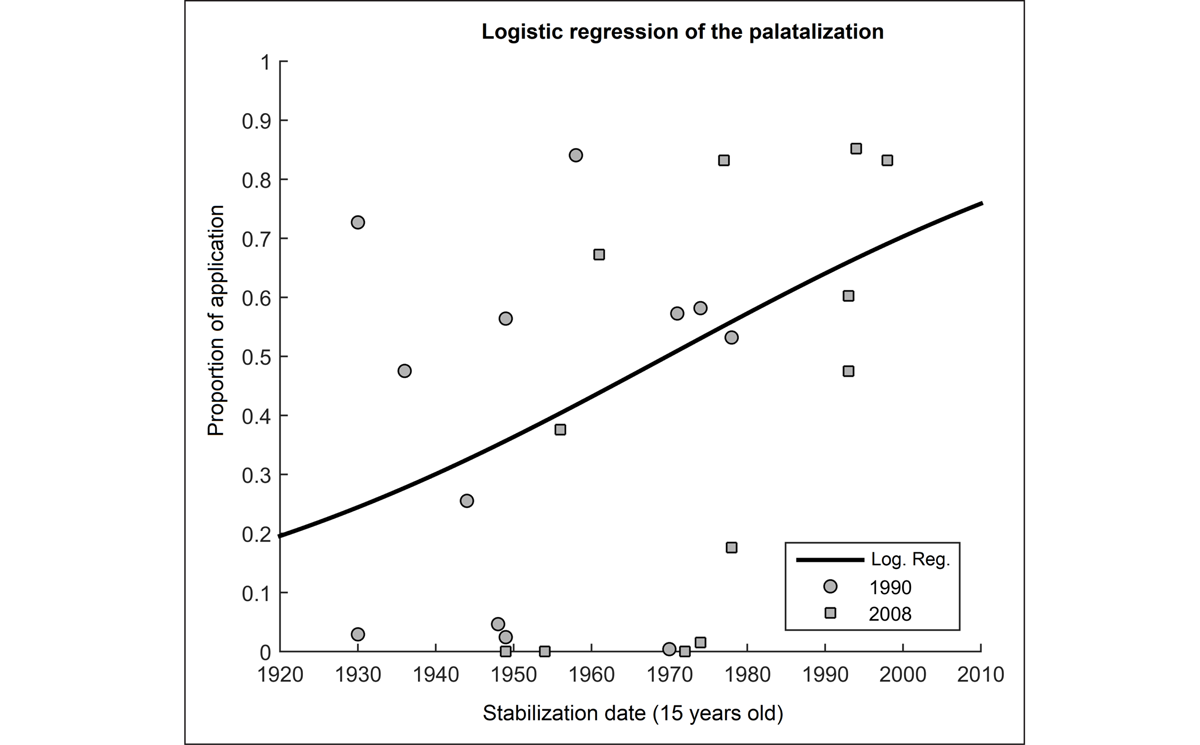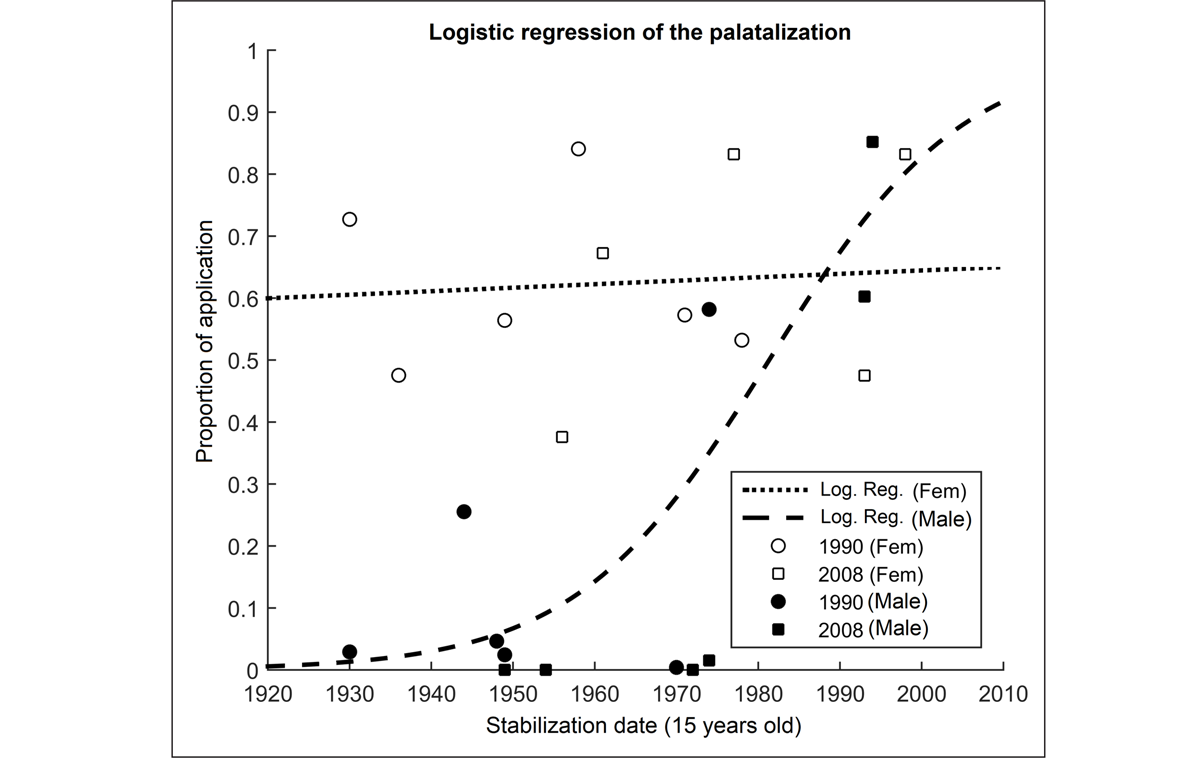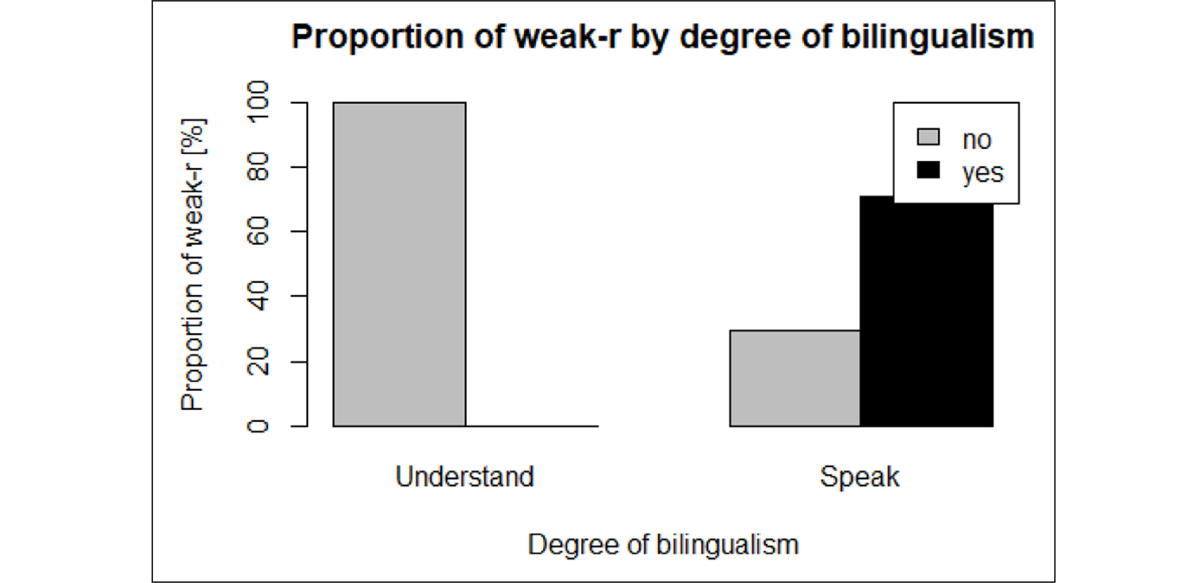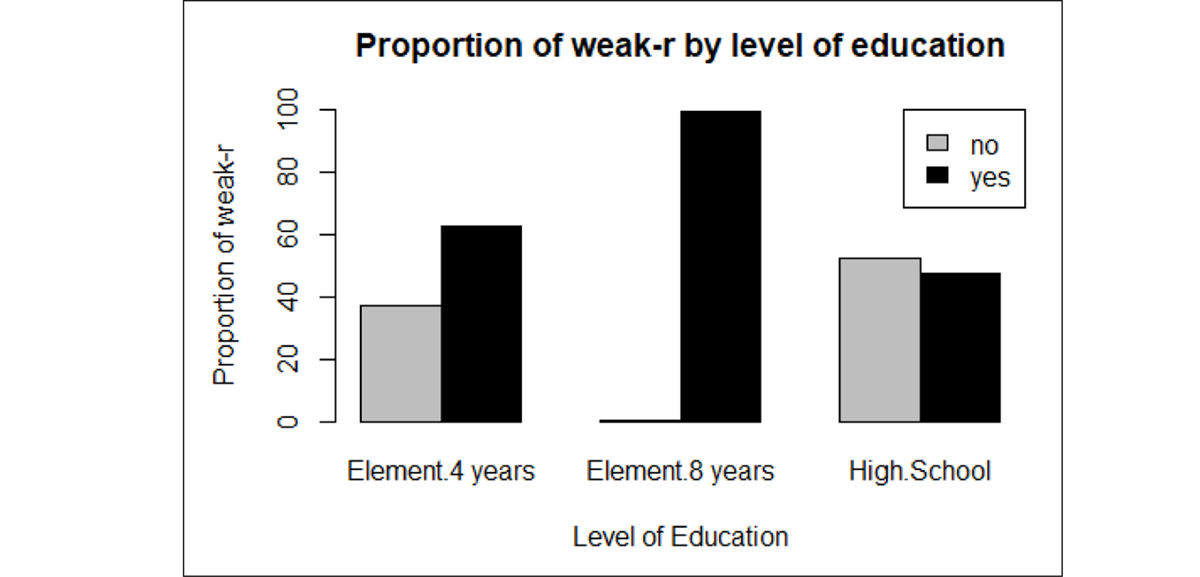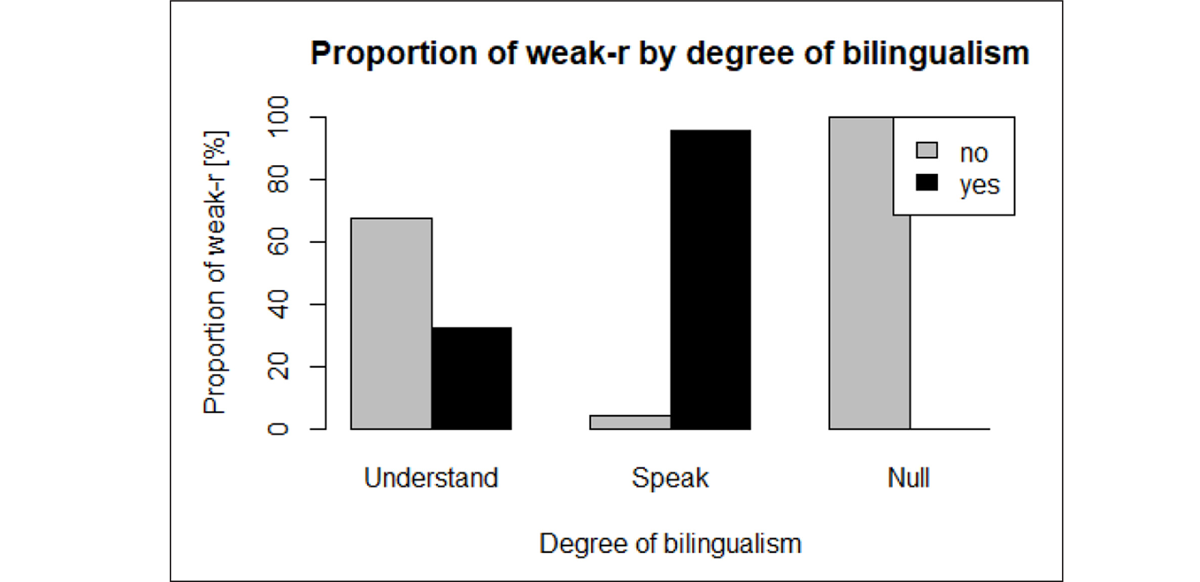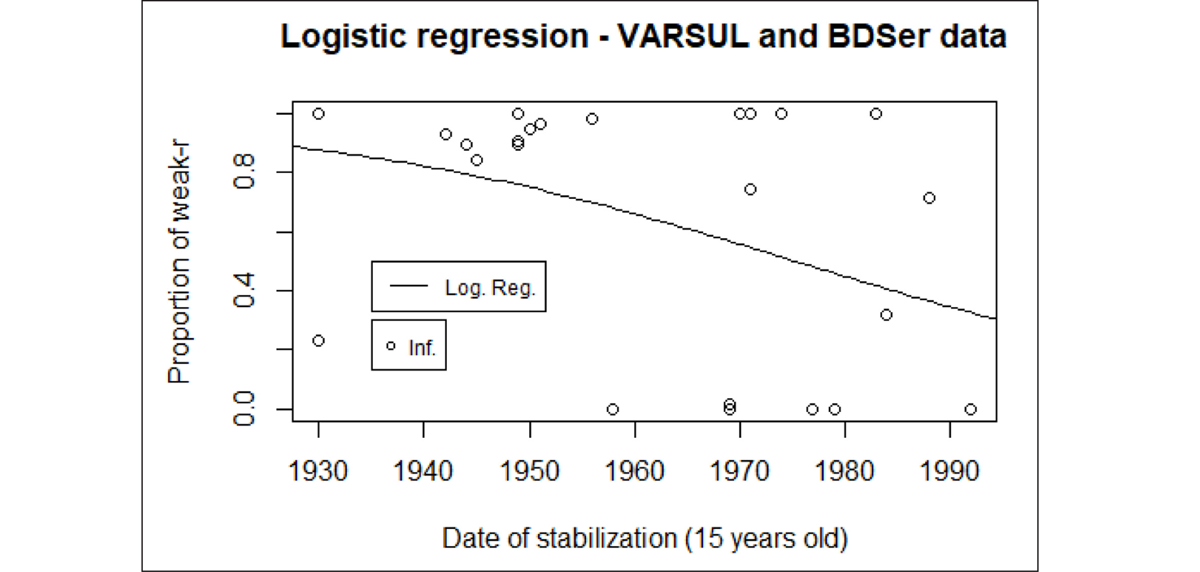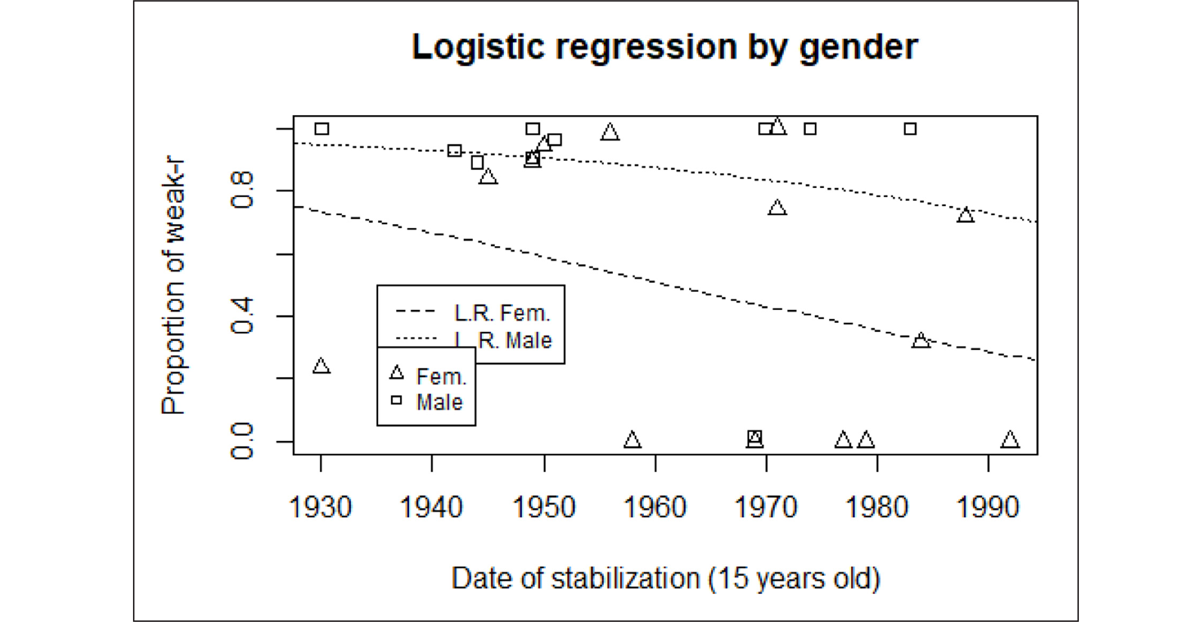1. Introduction
The emigration of Italians to Brazil between the second half of the 19th century and the beginning of the 20th century promoted the contact of Portuguese with Italian dialects.1 In the state of Rio Grande do Sul (RS), located in Southern Brazil, the variety of Brazilian Portuguese (BP) currently spoken in the former Italian colonial region (ICR-RS) has characteristics ascribed to this contact. One of them is the variable production of an alveolar tap (weak-r) where one would expect an alveolar trill (strong-r) or its fricative variants (glottal/velar fricative),2 as in a[ɾ]oz instead of a[r]oz or a[h]oz ‘rice’, chu[ɾ]asco instead of chu[r]asco or chu[h]asco ‘barbecue’ (Azeredo, 2012; Frosi & Mioranza, 1983; Battisti & Martins, 2011).
Other phonetic traits of BP in contact with Italian immigration languages3 are not exclusive to the variety. They result from variable phonological processes that are widespread in BP but that occur at lower rates in ICR-RS than in other regions in Brazil, such as the vocalization of the alveolar lateral approximant in coda position (ba[l]de~ba[w]de ‘bucket’, Brazi[l]~Brazi[w]) (Quednau, 1993; Battisti & Moras, 2015; Battisti & Moras, 2016) and the palatalization of alveolar plosives before high front vocoids ([t]ia~[t͜ʃ]ia ‘aunt’, [d]ia~[d͜ȝ]ia ‘day’, gen[t]e~gen[t͜ʃɪ] ‘people’, on[d]e~on[d͜ȝɪ] ‘where’) (Almeida, 2000; Battisti et al., 2007; Battisti & Dornelles Filho, 2012).
The variable realization under investigation in this paper is the production of a weak-r where one would expect a strong-r. Its pattern of variation and change is compared with that of the two other processes, the vocalization of the alveolar lateral approximant in coda position (henceforth vocalization) and the variable palatalization of alveolar plosives before high front vocoids (henceforth palatalization). The aforementioned studies show that the three processes produce changes that are in progress in BP in contact with Italian immigration languages. While the production of a weak-r where one would expect a strong-r is decreasing, vocalization and palatalization are increasing.
A previous study (Battisti & Dornelles Filho, 2016) on the BP spoken in Flores da Cunha, a city in the ICR-RS, found that vocalization progressed faster than palatalization in the same period. Using real-time trend analysis (Labov, 1994), the authors examined the proportions of rule application in successive generations and demonstrated that the processes follow distinct patterns of change: generational change (gradual increase in the proportions of rule application from generation to generation) in palatalization, communal change (intraindividual changes in addition to generational ones) in vocalization. This article advances the study by Battisti & Dornelles Filho (2016). It analyzes the production of a weak-r where one would expect a strong-r in the BP spoken in Flores da Cunha.
Palatalization and vocalization generally occur below the level of social awareness in Flores da Cunha (Battisti & Dornelles Filho, 2012, Battisti & Dornelles Filho, 2015, 2016), and the resulting forms are not stigmatized. Differently, the realization of a weak-r where one would expect a strong-r is relatively stigmatized in BP in contact with Italian immigration languages (Frosi, Faggion & Dal Corno, 2017; Santos, 2001). This situation poses the guiding question of the present study: what is the pattern of linguistic variation and change involving stigmatized forms in varieties of BP in contact with Italian immigration languages?
The article follows the theoretical-methodological assumption of ordered heterogeneity of variationist sociolinguistics (Labov, 1972; Labov, 1994; Labov, 2001; Labov, 2010), by which linguistic variation is correlated both to categories of the social organization of speech communities and to aspects of linguistic structure itself. Statistical analysis (mixed effects logistic regression) is performed with R (Venables, Smith & The R Core Team, 2022) in a real-time trend study, with data referring to 1990 from the VARSUL database4 and to 2008–2009 from the BDSer database.5 The objective of the study is to identify the linguistic and social factors correlated to the realization of weak-r in order to elucidate the pattern of variation and change. The hypotheses here tested are that, in the BP of Flores da Cunha, (i) the production of weak-r is correlated with sex (male), age group (elderly) and syllable position in the phonological word, as attested in previous studies (Battisti & Martins, 2011; Azeredo, 2012); (ii) given the stigmatization of the variant, the production of weak-r is declining sharply in the community in a pattern of communal change (intraindividual changes in addition to generational ones).
The main contribution of the article is the heuristic exploration of the assumptions of generational change (Labov, 1994) and asymmetry of language transmission (Labov, 2010) in the statistical analysis to study the pattern of variation and change of the phonetic trait under investigation, the realization of /r/ in syllabic onset as a weak-r where one would expect a strong-r. The analytical procedures adopted here allow to depict the path of change in the speech community over almost 70 years. Results show a slight decline of rule application (the realization of weak-r where one expects a strong-r). This finding contrasts with Battisti & Dornelles Filho (2016) regarding palatalization and vocalization, processes that are advancing in the speech community.
2. The speech community: the city of Flores da Cunha
Flores da Cunha is one of the 55 municipalities that make up the ICR-RS, a region located in the northeast of the state (Figure 1). Its population was estimated at 31,352 inhabitants in 2021 (Instituto Brasileiro de Geografia e Estatística 2022). Although relatively small by Brazilian standards, the town shares a border with Caxias do Sul, a metal-mechanic hub and the largest city in the countryside of Rio Grande do Sul (523,716 inhabitants in 2021). Flores da Cunha occupies an area of 276,231 square kilometers and, like the other municipalities in the region, has an extensive rural area, occupied by small family farms devoted to the production of fruit and vegetables and the raising of poultry, dairy cows, and pigs. The economy is diverse: in addition to agriculture, poultry farming and pig farming in rural areas, there is trade, provision of services and manufacturing in the urban area. Industry is mainly dedicated to the manufacturing of furniture and to the production of wine and grape juice. The town is recognized as the largest producer of wines and grapes in Brazil (according to the City Government of Flores da Cunha,6 based on information provided by Ibravin [Brazilian Institute of Wine] and by SEAPA/RS [Secretary of Agriculture, Livestock and Agribusiness of the State of Rio Grande do Sul]) and the second-largest furniture cluster in the state.
Flores da Cunha in Rio Grande do Sul and Brazil (Battisti & Dornelles Filho, 2012, p. 1124).
In Flores da Cunha, social practices identified with the Italian ethnic origins of the town are expressed mainly in the cuisine and in the culture of grapes and wine, traditions explored by local tourism in celebrations such as the Harvest Festival (Mecca et al., 2022). Bilingual speakers of BP and Italian immigration languages live mainly in rural areas, their bilingual practices are predominantly oral (Battisti & Martins, 2011). As previously mentioned, the BP variety spoken in Flores da Cunha and other speech communities in the ICA-RS shows traces of the contact with Italian immigration languages.
3. The production of weak-r and other phonological processes in BP in contact with Italian immigration languages
There are two contrastive rhotics in the Portuguese phonological system, /r/ and /ɾ/, called respectively strong-r and weak-r in this paper. The contrast is evidenced only in syllabic onset in intervocalic position (Camara Jr., 1970):
- (1)
- /muro/ murro ‘punch’
- /kareta/ carreta ‘cart’
- /karo/ carro ‘car’
- /ɛra/ erra ‘to make mistakes, 3ps Past’
- /muɾo/ muro ‘wall’
- /kaɾeta/ careta ‘grimace’
- /kaɾo/ caro ‘expensive’
- /ɛɾa/ era ‘to be, 3ps Past’
In word-initial syllabic onset, only /r/ occurs: /roupa/ roupa ‘clothing’, /rua/ rua ‘street’, /relɔʒio/ relógio ‘clock, watch’.
The contrast between /r/ and /ɾ/ is neutralized in syllabic coda, a position in which, according to Silva (2012), different rhotic segments are observed in BP: voiceless and voiced velar fricative [x, ɣ], voiceless and voiced glottal fricative [h, ɦ,], voiced alveolar tap [ɾ], voiced alveolar trill [r] and voiced retroflexes (tap [ɽ] or approximant [ɻ]).
In syllabic onset, there is variation in the production of /r/ but not in the production of /ɾ/. The most frequent variants of /r/ in onset in BP are the voiceless velar fricative [x] and the voiceless glottal fricative [h], while the least frequent variant is the multiple alveolar trill (Cardoso et al., 2014).7 Conversely, /ɾ/ is usually produced as voiced alveolar tap [ɾ] in the onset. Only in varieties of BP in contact with immigration languages, such as the one examined in this article, [ɾ] manifests both /ɾ/ and /r/ in onset position, at the beginning of the word and intervocallically.
Most studies on the production of a weak-r where one would expect a strong-r in BP in contact with Italian immigration languages deal with the realization in the framework of Labovian variationist theory (Labov, 1972; Labov, 1994; Labov, 2001; Labov, 2010). They analyze data from communities in the ICR-RS and Santa Catarina (SC), a neighboring state to Rio Grande do Sul. Except for Curioletti (2021), who performed a trinomial analysis distinguishing the alveolar tap (weak-r) from the alveolar trill and the fricatives (instantiations of strong-r), the researchers perform binomial statistical analyzes opposing weak-r to the combination of trill and fricatives. Some results are similar.
Concerning social predictor variables, weak-r correlates with variables Sex, Age Group, Bilingualism, Place of Residence. Female, younger people favor the alveolar trill or its fricative variants (velar or glottal), while the older population favors the tap in Flores da Cunha (Azeredo, 2012; Rossi, 2000; Battisti & Martins, 2011) and in Antônio Prado (Corrêa, 2016). In Chapecó, younger speakers and those over 55 years old favor the tap, while the intermediate age group does not favor it (Spessato, 2003). In Planalto, a district of the city of Concórdia, the alveolar trill is favored by middle-aged and older speakers, while the fricative variants are favored by young people (Curioletti, 2021). Regarding Bilingualism, the tap is more frequent in the speech of bilinguals in Flores da Cunha (Azeredo, 2012) and Chapecó (Spessato, 2003). Margotti (2004) also observes that bilinguals favor the tap in eight cities in Rio Grande do Sul and Santa Catarina. Battisti & Martins (2011) attest that the rural area favors the tap in Flores da Cunha.
Regarding linguistic predictor variables, weak-r correlates with variables Position of the Syllable in the Word and Number of Syllables in the Word. Weak-r is favored in medial word position in Caxias do Sul (2004), Flores da Cunha (Azeredo, 2012; Rossi, 2000; Battisti & Martins, 2011) and Chapecó (Spessato, 2003). Polysyllabic words favor the trill in Flores da Cunha (Rossi, 2000; Battisti & Martins, 2011).
Some of the studies suggest that the decline in the production of weak-r by younger people relates to their daily social practices, as moving to and from different speech communities to study and work (Battisti & Martins, 2011; Curioletti, 2021). This is because weak-r could be taken as a stereotype in Labovian terms – it occurs above social consciousness, shows some degree of stigmatization, is subject to meta-comments, mainly outside the speech community.
Therefore, in general terms, studies on the production of a weak-r where one would expect a strong-r in BP in contact with Italian immigration languages show that weak-r is favored by males, older, less educated bilingual speakers who live in rural areas. Conversely, the production of strong-r is favored by young, female subjects, maybe due to the stigmatization of weak-r. Medial word position favors weak-r, initial position disfavors it.
As stated in the introduction, generalized phonological processes in supralocal BP can be observed in BP in contact with Italian immigration languages but in moderate or low proportions. The vocalization of the alveolar lateral approximant in coda position and the variable palatalization of alveolar plosives before high front vocoids are two of them. Unlike the production of a weak-r where one would expect a strong-r, vocalization and palatalization are not stigmatized. Both processes are in progress.
Battisti & Dornelles Filho (2016) carried out a study on vocalization and palatalization in the BP of Flores da Cunha. In their study, the authors compare the results of two previous analyses on the BP of Flores da Cunha, both in real time (data from VARSUL and BDSer), one on vocalization (Battisti & Moras, 2016) and the other on palatalization (Battisti & Dornelles Filho, 2015). The analysis of vocalization found 12% of rule application8 in the VARSUL data (1990), favored by speakers aged 25–39 years, tonic and pretonic syllables, subsequent pause and labial consonants; and 77% in the BDSer data (2008–2009), favored by speakers aged 25–39 and 40–59 years, pretonic and posttonic syllables, subsequent labial consonants and high, back vowels. The analysis of palatalization found 41.7% of rule application in the VARSUL data (1990) and 51.7% in the BDSer data (2008–2009), favored by non-derived high triggering vowel, voiceless target consonants, female speakers between 25–39 years old in both periods. In other words, the two processes progressed in the BP spoken in Flores da Cunha in about 20 years and are conditioned by linguistic and social variables. However, the progress of vocalization was more prominent (from 12% to 77%) than that of palatalization (from 41.5% to 51.7%) during that period. Seeking to clarify this difference and using imagination as a heuristic resource (Garcia, 2019), Battisti & Dornelles Filho (2016) complement the comparison with a statistical analysis guided by two Labovian assumptions:
generational change (Labov, 1994), according to which our phonological system is defined in youth and stabilizes in adulthood. Language changes would result from changes in the community;9
asymmetry of language transmission (Labov, 2010), according to which men of the older generation (generation 1) are not involved in the change, men between 30 and 50 years old (generation 2) are the first to have mothers affected by the processes and show a rapid increase in application values equivalent to their mothers (between 50 and 70 years old). Thus, men would be about a generation behind their mothers until the end of the process, when the sex difference decreases, which would explain the eventual approximation in the indices of the female and male factors in a certain time interval.10
Battisti & Dornelles Filho (2016) consider the age declared by their 24 informants at the time of the sociolinguistic interviews. Under the premise that 15 years old11 is the age at which the phonological system would stabilize, the authors calculate the year in which each informant was 15 years old i.e. the year of the stabilization of their phonological system. With this information, the authors perform logistic regression analyses of vocalization and palatalization, according to the year of stabilization and to the sex of the informants. The results are in Figures 2 and 3 for vocalization and 4 and 5 for palatalization.
Logistic regression of the application of the vocalization of /l/ according to the informant’s linguistic stabilization date (total data) (Battisti & Dornelles Filho, 2016, p. 236).
Logistic regression of the application of the vocalization of /l/ according to the informant’s linguistic stabilization date by sex (Battisti & Dornelles Filho, 2016, p. 238).
The analysis of the realization of weak-r according to the age of stabilization of the informants’ phonological system suggests that there would already be some application of the palatalization in the informants’ BP around 1920 (Figure 4). The vocalization, in turn, would be practically null (Figure 2). These distinct patterns of change suggest generational change (gradual increase in the proportions of the application of the rule from generation to generation) in palatalization and communal change (intraindividual changes beyond generational ones, cf. Labov 1994) in vocalization. The analysis stratified by sex indicates that, in vocalization (Figure 3), the regression curves would be similar, that is, the vocalization by men and women would have grown in a similar way, with the proportion of the female factor higher than that of the male factor over time (asymmetry in linguistic transmission); in palatalization (Figure 5), the female factor would have remained relatively stable for almost 100 years, while in the male factor the proportions of rule application would have rapidly increased between the 1950s and 1990s, when the community expanded due to urbanization and industrial development.
As with vocalization and palatalization, what would be the pattern of linguistic variation and change in the production of weak-r in the BP of Flores da Cunha? This is what we seek to clarify in this article, testing the hypothesis that, since this variable is a stereotype, it would be in sharp decline in the community in a path of communal change, as mentioned in the introduction.
Logistic regression of the application of the palatalization of /t, d/ according to the informant’s linguistic stabilization date (total data) (Battisti & Dornelles Filho, 2015, p. 240).
Logistic regression of the application of the palatalization of /t, d/ according to the informant’s linguistic stabilization date by sex (Battisti & Dornelles Filho, 2015, p. 241).
4. Methodology
Two analyses are presented in this paper: a real-time analysis (trend study)12 (Labov, 1994) of the realization of weak-r in the BP of Flores da Cunha and a (regression) analysis of the variable according to the age of stabilization of the phonological system (cf. Battisti & Dornelles Filho, 2016).
The data used in the analyses were extracted from 24 sociolinguistic interviews, 12 belonging to the VARSUL (1990) collection, 12 belonging to the BDSer (2008-2009) collection.13 Informants were stratified by sex (female, male) and age group (from 25 to 39 years old, from 40 to 59 years old, and 60 years old or older). 1,881 items of data are analyzed, 1,072 from VARSUL and 769 from BDSer. The models obtained by means of multivariate logistic regression analyses are compared.
The data collected from the interviews were coded in two spreadsheets, one for VARSUL data and one for BDSer data, considering the following variables: (a) response variable: realization of weak-r where one would expect a strong-r, coded yes for application of the rule, no for non-application of the rule; (b) predictor variables (i) linguistic: Syllable Position with Respect to the Stressed Syllable, Syllable Position in the Phonological Word, Number of Syllables in the Word; (ii) social: Age Group (25-39, 40-59, 60 or older), Sex (female, male) (Chart 1).
Predictor variables
| Linguistic variables |
|
Syllable Position with Respect to the Stressed Syllable Tonic: roça ‘farmland’, arroz, ‘rice’ Pretonic: restinga. ‘moist broadleaf forest’, reúna ‘to gather, 3ps’ Posttonic: carro ‘car’, Inglaterra ‘England’ |
|
Syllable Position in the Phonological Word Initial: rosto ‘face’, roupa ‘clothing’ Medial: carro ‘car’, morrer ‘to die’ |
|
Number of Syllables in the Word Monosyllabic + Disyllabic word14: rum ‘rum’, rosa ‘rose’ Trisyllabic word: rápido ‘quick’, relevo ‘relief’ Polysyllabic word: romântico ‘romantic’, revolucionário ‘revolutionary’ |
| Social variables |
|
Sex Male Female |
|
Age Group 25–39 years old 40–59 years old 60 years old or older |
Source: the authors.
Data were also coded for the Informant and Word variables, included as random variables in mixed-effects statistical models.15
The VARSUL and the BDSer samples are balanced for sex and age, but not for level of education and degree of bilingualism (considering their use of Portuguese, the majority language, and Italian immigration languages), that is why level of education and degree of bilingualism do not correspond to predictor variables in the regression models. Information on education level and degree of bilingualism is used only when discussing the proportions of the production of weak-r, considering the following categories: (i) level of education: Elementary School-4 years, Elementary School-8 years, High School; (ii) degree of bilingualism: speaks (Italian immigration languages), understands (Italian immigration languages) and null (does not speak or understand Italian immigration languages).16
The statistical analysis is performed with the R program (Venables, Smith & The R Core Team, 2022) in the RStudio interface. It begins by calculating the proportion of application of the response variable per factor of each controlled predictor variable. Based on these proportions, a chi-square (Pearson’s) test is carried out for all the predictor variables, to verify if there is a (significant) difference between the proportions of application by the factors of each variable. Only the variables that present a significant p-value (equal to or less than 0.05) in the chi-square test are included in the regression models. The logistic regression analysis performed is of mixed effects, mixing fixed-effects variables (Chart 1) and random variables (Informant, Word).
The objectives of the real-time analysis are to identify the linguistic and social factors correlated to weak-r in each period under analysis and, in the comparison of the models, to clarify the conditioning factors of the process in the path of the variation and change. We test the hypotheses that the production of weak-r (a) has declined in about 20 years and (b) its application correlates with sex (male), age (elderly) and position of the syllable in the word in the BP of Flores da Cunha, both in the VARSUL and in the BDSer samples, as attested in previous studies (Azeredo, 2012; Battisti & Martins, 2011).
The analysis of the realization of weak-r according to the age of the stabilization of the phonological system replicates the procedures of Battisti & Dornelles Filho (2016), described in section 2, considering the proportions of realization of a weak-r where one would expect a strong-r by informant and the year each was 15 years old. Statistical regression analysis is performed with the R program, according to the age of stabilization, which is stratified by sex. Due to the stereotyping around the variant, the hypothesis tested in the analysis is that the decline of weak-r follows a pattern of communal change (intraindividual changes in addition to generational changes), with a sharp decrease in the proportions of application of the process over the period.
5. Presentation and discussion of the results
The results of the analyses do not confirm the hypotheses tested. The real-time analysis (trend study) shows that the probability of occurrence of weak-r has not declined in about 20 years. It remains stable, which can be seen from the total proportions of rule application observed: 66% (707/1,072) in the VARSUL data, 65% (503/769) in the BDSer data.
In the analysis of the VARSUL (1990) data, the predictor variables Syllable Position with Respect to the Stressed Syllable and Number of Syllables in the Word did not present a significant p-value in the chi-square test; therefore, they were not included in the regression model. The predictor variable Syllable Position in the Phonological Word (henceforth Syllable Position), Sex, Age Group (fixed effects), in addition to Word and Informant as random variables, are included in the regression model. The results of the model17 are presented in Table 1.
Estimates of the model parameters (logistic regression, generalized linear model with mixed effects) of the realization of a weak-r where one would expect a strong-r in the BP of Flores da Cunha – VARSUL.
| Variable | Applic./Tokens | Estimate | Standard error | z-value | p-value |
| Syllable Position | |||||
| Initial (ref. value) | 396/626 (63%) | ||||
| Medial | 311/446 (70%) | 0.594 | 0.344 | 1.727 | 0.084 . |
| Sex | |||||
| Female (ref. value) | 268/611 (44%) | ||||
| Male | 439/461 (95%) | 8.583 | 4.869 | 7.763 | 0.078 . |
| Age Group | |||||
| 40–59 years old (ref. value) | 291/319 (91%) | ||||
| 25–39 years old | 171/407 (42%) | –1.857 | 5.504 | -0.337 | 0.735 |
| 60 years old or older | 245/346 (71%) | 2.4103 | 4.621 | 0.522 | 0.602 |
-
Source: the authors.
MODEL 1. WEAK R ~ SYLLABLE POSITION + SEX + AGE + (1 | INFORMANT) + (1 | WORD).
N = 1,072.
Intercept = –3.0080.
The results in Table 1 show slight correlations (estimates with a p-value less than 0.1) of predictor variables Syllable Position and Sex with the production of weak-r. Regarding Syllable Position, with Initial as the reference value, the estimate of the Medial factor suggests that this syllable position in the phonological word favors the application of the rule in the VARSUL data. Regarding Sex, with Female as the reference value, the Male factor favors weak-r. However, when controlling the interaction of Sex and Age Group in another model, the slight correlation of the rule with Sex is not upheld. That is, Sex and Age Group interact, but their interaction is not significant. Furthermore, it affects the results of individual variables. Thus, the only (slight) correlation that could be stated from the results of the best statistical model obtained (Table 1) is that of Syllable Position in the VARSUL data.
In the analysis of the BDSer (2008-2009) data, as in the analysis of the VARSUL data, the predictor variables Syllable Position with Respect to the Stressed Syllable and Number of Syllables in the Word did not present a significant p-value in the chi-square test. Therefore, they were not included in the regression model. Again, predictor variables Syllable Position, Sex and Age Group are included in the model as fixed-effect variables, and Word and Informant as random variables. The results of the model are presented in Table 2.
Estimates of model parameters (logistic regression, generalized linear model with mixed effects) of the realization of a weak-r where one would expect a strong-r in the BP of Flores da Cunha – BDSer.
| Variable | Applic./Tokens | Estimate | Standard error | z-value | p-value |
| Syllable Position | |||||
| Initial (ref. value) | 303/486 (62%) | ||||
| Medial | 200/283 (71%) | 0.7628 | 0.4281 | 1.782 | 0.074 . |
| Sex | |||||
| Female (ref. value) | 255/460 (55%) | ||||
| Male | 248/309 (80%) | 7.1773 | 3.7708 | 1.903 | 0.057 . |
| Age Group | |||||
| 40–59 years old (ref. value) | 85/226 (38%) | ||||
| 25–39 years old | 54/160 (34%) | 2.7074 | 4.6347 | 0.584 | 0.559 |
| 60 years old or older | 364/383 (95%) | 7.2247 | 3.6358 | 1.987 | 0.046 * |
-
Source: the authors.
MODEL 1. WEAK R ~ SYLLABLE POSITION + SEX + AGE + (1 | INFORMANT) + (1 | WORD).
N = 769.
Intercept = –5.3762.
The real-time analysis, therefore, does not confirm the hypothesis of a decline in the production of weak-r in about 20 years, nor the correlation with Sex and Age Group. The analysis shows that these variables interact in the two samples and that the interaction affects the estimates of the fixed variables in the models. The only hypothesis that seems to be confirmed is that of Syllable Position, with the Medial factor favoring the rule, but we take this result cautiously because the correlations attested are only slight.
The results here obtained seem to contradict Battisti & Martins (2011) and Azeredo (2012) in the sense that we do not observe a decrease in the production of a weak-r in the BP of Flores da Cunha. The contradiction may be due to differences in the design and procedures of the statistical analysis: Battisti & Martins (2011) performed an apparent-time analysis of a larger sample (2,151 items of data from 32 informants of BDSer), Azeredo (2012) performed a real-time analysis with data from BDSer and VARSUL with a smaller sample (1,593 items of data). Besides that, both studies used the Goldvarb program for the statistical analysis and did not carry out a mixed-effects regression analysis. Even so, two of our findings are relevant: the general proportions of rule application obtained for the VARSUL and BDSer samples, almost the same in 20 years, indicating stability of the realization of weak-r in the BP of Flores da Cunha; and the lack of correlation of weak-r with the social variables, especially with Age Group, in the analyses of both samples, which is coherent with the stability attested. Because of that, we cannot assert progress of the rule. Examining the level of education and the degree of bilingualism of our informants can shed some light into the discussion of those findings.
We crossed the proportions of realization of weak-r with variables Level of Education and Degree of Bilingualism. The chi-square test showed a significant difference in the application of the rule by factor of both variables. The results for the VARSUL sample are in Figures 6 and 7 and the results for the BDSer sample are in Figures 8 and 9.
VARSUL informants with a high degree of education (Figure 6) use weak-r less, VARSUL informants who only understand, do not speak Italian immigration languages (Figure 7) do not apply the rule. Differently, almost half (47%) of the BDSer informants with high degree of education (Figure 8) produce weak-r, and more than 30% of the informants who only understand, do not speak Italian immigration languages (Figure 9) apply the rule.
Altogether, these results (Figures 6 to 9) seem to suggest that the realization of weak-r is not change in progress. It has been incorporated into the BP of Flores da Cunha as a typical trait of the community. Among the informants of the most recent sample (BDSer) are people who do not speak or understand (Null) the Italian immigration languages. Besides that, the proportion of rule application increases among the informants with passive knowledge (do not speak, only understand) of the Italian immigration languages. It may be the case that weak-r, being one of the traces of the accent of the BP of Flores da Cunha, indexes local identity, as Curioletti (2021) found out in her ethnographic work in Planalto, a rural district of the city of Concórdia (in the state of Santa Catarina). The analysis of the realization of a weak-r where one would expect a strong-r according to the age of stabilization of the phonological system, whose results are presented below, adds relevant information to the discussion.
Under the premise that 15 years old is the age at which the phonological system stabilizes and having calculated the year in which each of the 24 informants (12 VARSUL informants, 12 BDSer informants) was 15 years old, it was possible to go back to 1930. With this piece of information, a logistic regression analysis was performed to obtain the estimated proportion of the production of weak-r at the time when the phonological system of the informants stabilized (Figure 10).
Figure 10 refers to the total data (VARSUL and BDSer data). The logistic regression curve shows that, as time passes, the proportion of the production of weak-r in the BP of Flores da Cunha declines from around 90% to approximately 30%. This result indicates that the phonological system acquired by the inhabitants of the town would be showing lower rates of application of the rule in successive generations. How to explain, therefore, the very similar total proportions obtained in the real-time analysis with VARSUL and BDSer data?
Total proportions are an average. Besides that, the VARSUL and BDSer samples were collected more recently, in 1990 and 2008-2009 respectively. Sex stratification of the regression according to the informant’s linguistic stabilization date (Figure 11) provides another answer to the question. It reveals a distinct behavior in the subgroups. The dotted regression line shows that the application of the rule by the male factor is higher than the application by the female factor (dashed regression line) and has declined only slightly (from about 95% to 75%) in almost 70 years.
Figure 11 shows that the realization of weak-r has been decreasing in the speech of both male and female informants, but the decline is greater among women (from almost 80% to less than 30%). This pattern conforms to the Labovian assumption of asymmetry in linguistic transmission. Nonetheless, there is no sharp decrease in the proportions of production of weak-r over the period in any of the sexes.
The results of the analysis by age of stabilization of the phonological system, therefore, do not confirm the hypothesis that the decline in the realization of weak-r would be sharp, following a pattern of communal change. The pattern is that of generational change i.e., a gradual decline in the proportions of rule application from generation to generation.
6. Conclusion
The analyses presented in this paper did not confirm both the hypothesis of a sharp decrease in the realization of weak-r in the BP of Flores da Cunha and the hypothesis of correlation of the production of weak-r with sex (male) and age group (elderly). The only hypothesis confirmed was that of the correlation of weak-r with syllable position (medial) in the phonological word.
The results here obtained contribute to clarifying the patterns of progression of sound changes in varieties of BP in contact with Italian immigration languages. They show that, as with vocalization and palatalization, which have been progressing in the BP of Flores da Cunha towards leveling with the supralocal BP, the realization of weak-r declined over a period of almost 70 years but stabilized between the years 1990 and 2008–2009, a pattern of progress that conforms to the gradual character of the generational change. That is, despite the tendency towards leveling of the BP of Flores da Cunha with supralocal patterns of Portuguese, the slow decline in the production of weak-r and its stabilization in the most recent period indicate the possibility that weak-r is being incorporated as a trait of the local accent.
Concerning the phonological system of Portuguese, the BP of Flores da Cunha and that of other Brazilian communities founded by Italian immigrants exhibit a different distribution of the alveolar tap than the one predicted (Camara Jr., 1970): in addition to being a variant of /R/ in syllabic coda (Callou, Leite & Moraes, 2002), the alveolar tap is one of the variants of /r/ in syllabic onset, a position in which it varies with the alveolar trill and the velar and glottal fricatives (Curioletti, 2021).
The results of the real-time analysis are not conclusive. They point to a possible favoring role of the medial syllable in the application of the rule.
The regression analysis considering the age of stabilization of the phonological system made it possible to trace the pattern of variation and change of the realization of weak-r in the BP of Flores da Cunha since at least as far back as 1930. The analysis also captures the different behavior of male and female speakers in the process. As a heuristic resource, this type of analysis should not be taken as a method to faithfully portray the investigated reality, but as a device to approach inaccessible empirical realities, which can only be treated by hypothesis, as is the case of the long process of language variation and change.
A future development of the study reported here may be a work in line with the third wave sociolinguistics (Eckert, 2012). Investigating the social meanings indexed by weak-r in stylistic practice may unveil the sound symbolism at work in variation and explain the relative stability of the variable in the BP of Flores da Cunha in recent years. This will add to the analysis of the social forces driving language variation and change in varieties of BP in contact with Italian immigration languages, both regarding weak-r and other linguistic variables circulating in local semiotic landscapes.
Notes
- According to De Boni and Costa (1982), the emigration of Italians to Brazil was related to the Italian unification in 1870. The unification changed the means of production and led to poverty, especially among rural populations. Emigration agents worked in Italy, promoting the process, and both Italian and Brazilian authorities were aware of this. For example, in the case of the province that became the current state of Rio Grande do Sul (RS), the Brazilian government offered advantages to the Italian settlers: the possibility of purchasing the plots of land destined for them by the local authorities, with easy payment (within a period of five years, without interest), transportation and lodging in the early days in the new country. De Boni and Costa (1982) estimate that between 80 and 100 thousand Italians arrived in Rio Grande do Sul between the second half of the 19th century and the beginning of the 20th century. Frosi and Raso (2011) explain that immigrants from 20 provinces located in 4 regions of Northern Italy (Veneto, Lombardia, Trentino-Alto Adige and Friuli Venezia Giulia) were destined for the former Italian colonial region of the state (ICR-RS). According to the researchers, therefore, 20 dialects were spoken in the ICR-RS around 1910. [^]
- Battisti (2021, p. 13) explains that “the consonant /r/ contrasts with /ɾ/ in the onset of syllables in intervocalic position in Portuguese (as in carro /karo/ ‘car’, caro /kaɾo/ ‘expensive’). Only /r/ occurs in the onset of word initial syllables. BP keeps this distribution.” A fricative segment is the preferred phonetic instantiation of /r/ in syllabic onset in BP (Callou & Leite, 1990), although an alveolar trill is occasionally attested (Noll, 2008) in this syllabic position. However, according to Monaretto (2010), three variants of /r/ are found in the syllabic onset in BP as spoken in the south of Brazil: besides the alveolar trill and the fricative variants, [ɾ] is observed. “Surprisingly, the occurrence of tap [ɾ] where one would expect an alveolar trill or fricative variants is more frequent than the other variants of /r/ in syllabic onset in the cities of Flores da Cunha and Panambi, in Rio Grande do Sul, and in Chapecó, in Santa Catarina, communities where BP is in contact with Italian and German dialects.” (Battisti, 2021, p. 14). [^]
- Altenhofen and Margotti (2011) use the term immigration languages to designate non-native minority languages spoken in Brazil, where Portuguese is the majority language. We will use the term Italian immigration languages along the paper in this sense when referring to Italian dialects spoken in Brazil. [^]
- VARSUL (Variação Linguística na Região Sul do Brasil) [Linguistic Variation in the Southern Region of Brazil] is a speech database shared by four higher education institutions in Southern Brazil: Universidade Federal do Rio Grande do Sul (UFRGS), Universidade Federal de Santa Catarina (UFSC), Universidade Tecnológica Federal do Paraná (UTFPR), Pontifícia Universidade Católica do Rio Grande do Sul (PUCRS). The sociolinguistic interviews of VARSUL are conducted with participants of both sexes (male, female) with different levels of education (Elementary I, Elementary II, High School) and ages (25–50 years old, 50 years old or more), residing in the capitals and some cities from the countryside of Rio Grande do Sul, Santa Catarina and Paraná, states in the Southern Region of Brazil. The interviews of the base sample of VARSUL were carried out in the early 1990s. Information available at: http://www.varsul.org.br/. [Last accessed April 05 2023]. [^]
- BDSer (Banco de Dados de Fala da Serra Gaúcha) [Speech Database of the Region of Serra Gaúcha], from Universidade de Caxias do Sul (UCS), in Rio Grande do Sul, includes sociolinguistic interviews from 4 municipalities in the ICR-RS: Caxias do Sul, Antônio Prado, São Marcos, Flores da Cunha. The interviews of BDSer were stratified according to the informants’ area of residence (rural, urban), sex (male, female), age group (15 to 25 years old, 30 to 45 years old, 50 to 65 years old, 70 years old or more), education (1st–4th grade of Elementary School, 5th–8th grade of Elementary School, 1st–3rd grade of High School, Higher Education – one or more years). The interviews in Flores da Cunha, used in this study, were carried out between 2008 and 2009. [^]
- Data provided by Município de Flores da Cunha (2022). [^]
- The fricativization of /r/ has been occurring in BP since the 1970s, according to Langaro (2005). It started in large cities and has been spreading to the countryside of Brazil since then. The other possible realization of strong-r in BP, the multiple alveolar trill, can be observed in Southern BP varieties, but it is infrequent. [^]
- In quantitative Labovian analyses, the term rule refers to the dependent (or response) variable, and rule application refers to the occurrence of the dependent variable in the data (Tagliamonte, 2007). [^]
- Phonetic-acoustic analyses such as that by Harrington (2006), with longitudinal data on the production of the vowel /i/ in English (in a word such as ‘happy’), show that there are subtle changes in the production of the segments throughout adult life. However, these changes are marginal and conform to the speech pattern of the community. In the author’s words, “as sound change takes place in the community it has a gradual, and perhaps imperceptible influence on adults’ phonetic categories over a long period of time in a way that is reminiscent of the Neogrammarian position” (Harrington, 2006, p. 454). [^]
- The asymmetry of language transmission was first proposed by Labov (1990) as the asymmetry of the caregiving situation, an explanation to the fact that sexual differentiation is independent of social class at the beginning of a change. According to the author, women of all social classes are most often the innovators in change from below, a principle “found to be active in most of the linguistic changes in progress studied by quantitative means in the past several decades” (Labov, 1990, p. 216). Although, according to Labov (1990), the ethnographic perspective of Eckert (1989) “… provided the most comprehensive report yet published on her own examination of the social matrix of sound change in a Northern Cities high school …”, his own report takes “… a broader approach to the resolution of the problems of sexual differentiation, drawing upon large-scale surveys of the speech community” (Labov, 1990, p. 207). The present paper adopts the Labovian perspective, obtained from studies of sociolinguistic stratification in the community, although we recognize, in line with Eckert (1989), that women construct gender projections differently in different communities. [^]
- The age of 15 years was arbitrarily taken to delimit youth because (i) individuals from 15 to 19 years old form one of the youngest age groups (adolescents) in studies of linguistic variation in apparent time (Labov, 1994); (ii) 15 years old is the minimum age required in Brazil to enroll in federal education programs such as the Youth and Adult Education [Educação de Jovens e Adultos, EJA]. [^]
- Real-time analyses of the trend study type are designed “to make use of the present to interpret the past: to return to the scene of an earlier study and repeat it as closely as possible” (Labov, 1994, p. 75). [^]
- Part of the data come from the sample of Azeredo (2012). [^]
- In the study by Azeredo (2012), the researcher considered only disyllabic words, because, according to her, there were very few monosyllabic words in the sample: “o programa de análise estatística poderia dar origem a resultados pouco significativos, por isso, optou-se pela eliminação dos monossílabos do conjunto de dados” [the statistical analysis software could give rise to negligible results, so we chose to eliminate monosyllabic words from the data set] (Azeredo, 2012, p. 46). In the present study, the monosyllabic words were also scarce – Rui [proper name] (5 occurrences), rir ‘to laugh’ (2 occurrences), rei(s) ‘king(s)’ (4 occurrences), rio ‘river’ (2 occurrences), ri ‘to laugh, 3ps’ (2 occurrences), roll (1 occurrence), rum ‘rum’ (2 occurrences), rim(ns) ‘kidney(s)’ (7 occurrences), but we decided to group them with disyllabic words, so as not to eliminate them from the sample. [^]
- In mixed-effects logistic regression statistical analyses, both fixed-effects variables (such as those in Chart 2 in this article) and random variables (whose effects correspond to a range of values not controlled by the analyst) are included in the models. Incorporating predictor variables such as Informant and Word as random variables to the statistical models minimizes the effect of commonly repeated words or individual characteristics of the informants on the results achieved, as explained by Oushiro (2017). The mixed-effects analyses are a main difference between the analyses in this article and those performed in previous Labovian studies of the realization of a weak-r where one would expect a strong-r in BP in contact with Italian immigration languages. [^]
- Even though level of education and degree of bilingualism were not predictor variables in the regression models, data were coded for the two variables. The variable degree of bilingualism has two levels in the coding of VARSUL data (speaks, understands) because all 12 VARSUL informants are bilinguals, but it has three levels in the coding of BDSer data (speaks, understands, null) because 2 of the 12 informants are not bilingual. [^]
- If a p-value is less than 0.1, it is flagged with a dot (.). If a p-value is less than 0.05, it is flagged with one star (*). If a p-value is less than 0.01, it is flagged with 2 stars (**). If a p-value is less than 0.001, it is flagged with 3 stars (***). [^]
Competing interests
The authors have no competing interests to declare.
References
Almeida, M. A. B. de. (2000). A variação das oclusivas dentais na comunidade bilíngue de Flores da Cunha: uma análise quantitativa [The variation of dental stops in the bilingual community of Flores da Cunha: a quantitative analysis]. [Unpublished masters dissertation]. Pontifícia Universidade Católica do Rio Grande do Sul.
Altenhofen, C. V., & Margotti, F. W. (2011). O português de contato e o contato das línguas de imigração no Brasil [Contact Portuguese and the contact of immigration languages in Brazil]. In H. Melo, C. V. Altenhofen & T. Raso (Orgs.). Os contatos linguísticos no Brasil [Linguistic contacts in Brazil] (pp. 289–315). Belo Horizonte: Editora UFMG.
Azeredo, P. S. (2012). A troca da vibrante por tepe em onset silábico: uma análise de variação e mudança linguística na comunidade bilíngue de Flores da Cunha (RS) [The exchange of trill for tap in syllable onset: an analysis of linguistic variation and change in the bilingual community of Flores da Cunha (RS)]. [Masters dissertation, Universidade Federal do Rio Grande do Sul]. Lume – Repositório Digital UFRS. http://hdl.handle.net/10183/56028
Battisti, E. (2021). Phonological variation and change in Brazilian Portuguese. Oxford Research Encyclopedias, Linguistics – online. DOI: http://doi.org/10.1093/acrefore/9780199384655.013.488
Battisti, E., & Dornelles Filho, A. A. (2012). Palatalização das plosivas alveolares em Flores da Cunha: variação linguística e práticas sociais [Palatalization of alveolar plosivas in Flores da Cunha: linguistic variation and social practice]. Alfa: Revista de Linguística, 56(2), 1117–1149. DOI: http://doi.org/10.1590/S1981-57942012000300016
Battisti, E., & Dornelles Filho, A. A. (2015). Análise em tempo real da palatalização de /t/ e /d/ no português falado em uma comunidade ítalo-brasileira [Real time analysis of the palatalization of /t/ and /d/ in Portuguese spoken in an Italian-Brazilian community]. Revista da ABRALIN, 14(1), 221–246. DOI: http://doi.org/10.5380/rabl.v14i1.42492
Battisti, E., & Dornelles Filho, A. A. (2016). Mudança fônica em progresso no português de contato: palatalização de /t d/ e vocalização de /l/ numa comunidade ítalo-brasileira [Sound change in progress in contact Portuguese: palatalization of /t, d/ and vocalization of /l/ in an Italian-Brazilian community]. Revista virtual de estudos da linguagem – ReVEL, 13, 218–244.
Battisti, E., & Martins, L. B. (2011). A realização variável de vibrante simples em lugar de múltipla no português falado em Flores da Cunha (RS): mudanças sociais e linguísticas [The variable realization of alveolar tap where one would expect an alveolar trill in Flores da Cunha (RS) Portuguese: social and linguistic changes]. Cadernos do IL, 42, 146–158. DOI: http://doi.org/10.22456/2236-6385.26018
Battisti, E., & Moras, V. T. (2015). Análise em tempo aparente da vocalização variável da lateral pós-vocálica em Flores da Cunha (RS) [Apparent time analysis of vocalization of the post-vocalic alveolar lateral approximant in Flores da Cunha (RS)]. Caderno de Letras – UFPEL, 24, 37–54. DOI: http://doi.org/10.15210/cdl.v0i24.7273
Battisti, E., & Moras, V. T. (2016). A vocalização da consoante lateral em coda silábica em uma variedade de português brasileiro: análise sociolinguística em tempo real [The vocalization of the lateral consonant in syllabic coda in a variety of Brazilian Portuguese: real-time sociolinguistic analysis]. Gragoatá, Niterói, 40, 90–112. DOI: http://doi.org/10.22409/gragoata.v21i40.33376
Battisti, E., et al. (2007). Palatalização das oclusivas alveolares e a rede social dos informantes [Palatalization of alveolar stops and the social network of the informants]. Revista virtual de estudos da linguagem – REVEL, 5(9), 1–20.
Callou, D., & Leite, Y. (1990) Iniciação à fonética e à fonologia [Introduction to phonetics and phonology]. Rio de Janeiro: Jorge Zahar Editor.
Callou, D., Leite, Y., & Moraes, J. (2002). Processo(s) de enfraquecimento consonantal no português do Brasil [Process(es) of consonant weakening in Brazilian Portuguese.]. In M. B. M. Abaurre & A. C. S. Rodrigues (Orgs.). Gramática do português falado [Grammar of the spoken Portuguese] (pp. 537–555). Campinas, SP: Editora da UNICAMP.
Camara, J. M., Jr. (1970). Estrutura da língua portuguesa [Structure of the Portuguese language]. Petrópolis: Vozes.
Cardoso, S. A. M. da S., Mota, J. A., Aguilera, V. de A., Aragão, M. Do S. S., Isquerdo, A. N., Razky, A., Margotti, F. W., & Altenhofen, C. V. (2014). Atlas linguístico do Brasil [Brazilian linguistic atlas]. Londrina: EDUEL.
Corrêa, R. da C. (2016). A realização variável de vibrante simples em lugar de múltipla em onset silábico no português falado em Antônio Prado-RS [The variable realization of the flap instead of trill in syllable onset in the Portuguese spoken in Antônio Prado-RS]. [Masters dissertation, Universidade Federal do Rio Grande do Sul]. Lume – Repositório Digital UFRS. http://hdl.handle.net/10183/142540. DOI: http://doi.org/10.15448/1984-4301.2017.1.25056
Curioletti, D. S. S. (2021). A realização variável de /r/ em onset silábico no português falado por ítalo-brasileiros do distrito de Planalto, Concórdia (SC): produção e percepções linguísticas [The variable realization of /r/ in syllable onset in the Portuguese spoken by Italian-Brazilians from the district of Planalto, Concórdia (SC): production and linguistic perceptions. [PhD thesis, Universidade Federal do Rio Grande do Sul]. Lume – Repositório Digital UFRS. http://hdl.handle.net/10183/233973
De Boni, L. A., & Costa, R. (1982). Os italianos do Rio Grande do Sul [The Italians in Rio Grande do Sul]. 2nd. ed. Porto Alegre: EST/Caxias do Sul: EDUCS/Porto Alegre: Editora Vozes Ltda.
Eckert, P. (1989). ‘The whole woman: sex and gender differences in variation’, Language Variation and Change, 1, 245–268. DOI: http://doi.org/10.1017/S095439450000017X
Eckert, P. (2012). Three waves of variation study: the emergence of meaning in the study of sociolinguistic variation. Annual Review of Anthropology, 41, 87–100. DOI: http://doi.org/10.1146/annurev-anthro-092611-145828
Frosi, V. M., Faggion, C. M., & Dal Corno, G. O. M. (2017). Prestígio e estigmatização: dialeto italiano e língua portuguesa da Região de Colonização Italiana do Nordeste do Rio Grande do Sul [Prestige and stigmatization: Italian dialect and Portuguese language in the region of Italian colonization in Northeastern Rio Grande do Sul]. Revista da ABRALIN, 7(2). https://revista.abralin.org/index.php/abralin/article/view/994. DOI: http://doi.org/10.5380/rabl.v7i2.52493
Frosi, V. M., & Mioranza, C. (1983). Dialetos italianos: um perfil linguístico dos ítalo-brasileiros do nordeste do Rio Grande do Sul [Italian dialects: a linguistic profile of Italian-Brazilians from Northearern Rio Grande do Sul]. Caxias do Sul: EDUCS.
Frosi, V. M., & Raso, T. (2011). O italiano no Brasil: um caso de contato linguístico e cultural [Italian in Brazil: a case of linguistic and cultural contact]. In H. Mello, C. V. Altenhofen & T. Raso (Orgs.) Os contatos linguísticos no Brasil [The linguistic contacts in Brazil] (pp. 317–347). Belo Horizonte: Editora UFMG.
Garcia, J. O. (2019). ‘A imaginação como recurso heurístico na construção do conhecimento científico e algumas implicações para o ensino de ciências’ [Imagination as a heuristic resource in the construction of scientific knowledge and some implications for science teaching] Caderno brasileiro de ensino de Física [Brazilian physics teaching notebook], 36(3), 660–674. DOI: http://doi.org/10.5007/2175-7941.2019v36n3p660
Harrington, J. (2006). ‘An acoustic analysis of happy-tensing in the Queen’s Christmas broadcasts’, Journal of Phonetics, 34, 439–457. DOI: http://doi.org/10.1016/j.wocn.2005.08.001
Instituto Brasileiro de Geografia e Estatística – IBGE. (2022). Cidades e Estados – Flores da Cunha [Cities and States – Flores da Cunha]. Governo do Brasil, Instituto Brasileiro de Geografia e Estatística. https://www.ibge.gov.br/cidades-e-estados/rs/flores-da-cunha.html
Labov, W. (1972). Sociolinguistic patterns. Philadelphia: University of Philadelphia Press.
Labov, W. (1990). ‘The intersection of sex and social class in the course of linguistic change’, Language Variation and Change, 2, 205–254. DOI: http://doi.org/10.1017/S0954394500000338
Labov, W. (1994). Principles of linguistic change: internal factors. Oxford/Cambridge: Blackwell.
Labov, W. (2001). Principles of linguistic change: social factors. Oxford/Cambridge: Blackwell.
Labov, W. (2010). Principles of linguistic change: cognitive and cultural factors. Malden/Oxford/West Sussex: Wiley-Blackwell. DOI: http://doi.org/10.1002/9781444327496
Langaro, A. J. (2005). ‘De vibrantes a fricativos: os róticos na dublagem brasileira’ [From trills to fricatives: the rhotics in Brazilian dubbing], Revista Trama, 1(2), 109–123. DOI: http://doi.org/10.48075/rt.v1i2.211
Margotti, F. W. (2004). Difusão sócio geográfica do português em contato com o italiano no Sul do Brasil [Socio-geographical diffusion of Portuguese in contact with Italian in Southern Brazil]. [PhD thesis, Universidade Federal do Rio Grande do Sul]. Lume – Repositório Digital UFRS. http://hdl.handle.net/10183/3911
Mecca, M. S., Conto, S. M. D., Bebber, T. L., & Michelon, F. F. (2022). ‘Vinho e paisagem na perspectiva da sustentabilidade no turismo de Flores da Cunha (RS) na pandemia da Covid-19’ [Wine and landscape from the perspective of sustainability in tourism in Flores da Cunha (RS) in the Covid-19 pandemic], Conjecturas [Conjectures], 22(1), 1417–1439. DOI: http://doi.org/10.53660/CONJ-574-208
Município de Flores da Cunha. (2022). Cidade – Dados gerais [City – General data]. Prefeitura do Município de Flores da Cunha. https://www.floresdacunha.rs.gov.br/secao.php?id=1
Noll, V. (2008). O português brasileiro: formação e contrastes [Brazilian Portuguese: formation and contrasts]. São Paulo: Globo.
Oushiro, L. (2017). Introdução à estatística para linguistas [Introduction to statistics for linguists]. [S.l.]: Zenodo. DOI: http://doi.org/10.5281/zenodo.1133792
Quednau, L. (1993). A lateral pós-vocálica no português gaúcho: análise variacionista e representação não-linear [The postvocalic lateral in the Portuguese in the state of Rio Grande do Sul: variationist analysis and non-linear representation]. [Masters dissertation, Universidade Federal do Rio Grande do Sul]. Lume – Repositório Digital UFRS. http://hdl.handle.net/10183/1443
Rossi, A. (2000). ‘A variação da vibrante múltipla no interior da palavra lexical na fala de descendentes italianos das cidades sulinas Chapecó/SC e Flores da Cunha /RS’ [The variation of the multiple trill inside the lexical word in the speech of Italian descendants in the Southern cities of Chapecó/SC and Flores da Cunha /RS], Working papers em linguística, 4(1): 54–69. DOI: http://doi.org/10.5007/%25x
Santos, S. R. P. dos. (2001). O Radicci no contato italiano-português da região de Caxias do Sul: identidade, atitudes linguísticas e manuntenção do bilinguismo [The Radicci in the Italian-Portuguese contact in the region of Caxias do Sul: identity, linguistic attitudes and maintenance of bilingualism]. [Masters dissertation, Universidade Federal do Rio Grande do Sul]. Lume – Repositório Digital UFRS. http://hdl.handle.net/10183/2275
Silva, T. C. (2012). Fonética e Fonologia do Português [Phonetics and Phonology of Portuguese]. 10th ed. São Paulo: Contexto.
Spessato, M. B. (2003). Linguagem e colonização [Language and colonization]. Chapecó: Argos.
Tagliamonte, S. A. (2007). Quantitative analysis. In R. Bayley & C. Lucas (Eds.). Sociolinguistic variation: theories, methods, and applications (pp. 190–214). Cambridge: Cambridge University Press.
Venables, W. N., Smith, D. M., & The R Core Team. (2022). R: a language and environment for statistical computing. Version 4.1.3 (2022-03-10). Wien: R Foundation for Statistical Computing. https://cran.r-project.org/doc/manuals/r-release/R-intro.pdf
